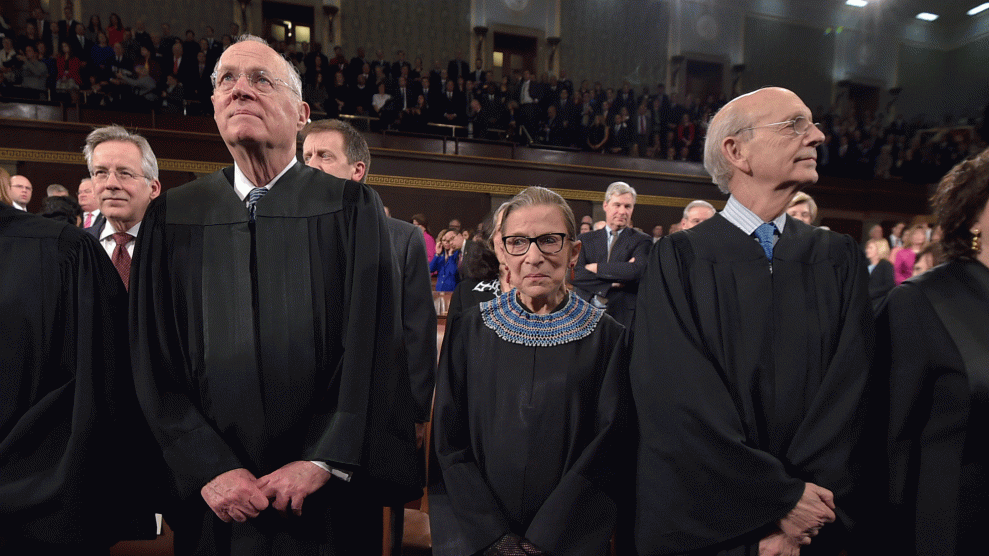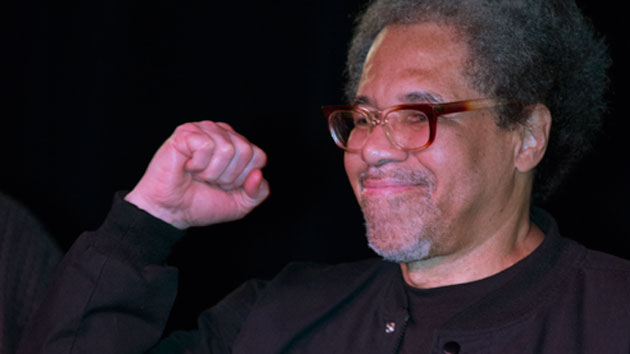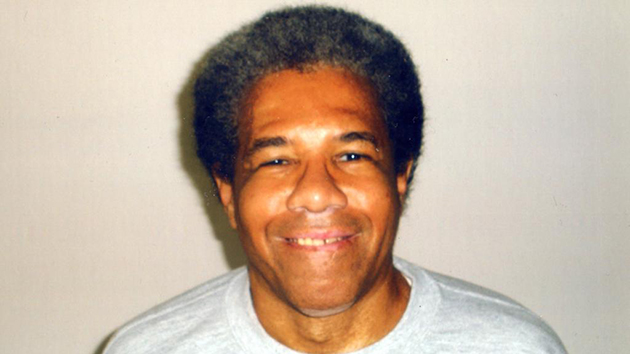
Supreme Court Justice Anthony Kennedy, left, and his colleagues at the 2016 State of the Union address.Mandel Ngan/AP
↵Update (6/6/16): After initially announcing on Monday morning that it would hear Bobby Moore’s case, the Supreme Court issued a correction later in the day, clarifying that it would decide only on the issue of the standard that Texas had used to determine whether Moore’s intellectual disability should disqualify him from execution. It won’t rule on the Eighth Amendment issues Moore raised relating to solitary confinement or extended waits on death row.
Bobby Moore has been on death row in Texas for more than 35 years, for a murder he committed in 1980 at the age of 20. He’s come close to dying twice; once, he was hours away from execution before a court intervened. For the past 15 years, he’s been in solitary confinement nearly 23 hours a day, unable to interact with other inmates, in a type of cell described in legal filings as “virtual incubators of psychoses.”
The Supreme Court is now considering Moore’s claim that his solitary incarceration and the long delay between his conviction and execution are violations of the Eighth Amendment’s ban on cruel and unusual punishment. Moore’s petition has been pending for nearly a month, but a decision on whether the Supreme Court will hear it could come on Monday. If the court takes up the case, its ruling could have profound implications for the nation’s nearly 3,000 death row inmates, who are often confined to solitary cells and await execution for an average of more than 15 years. If Moore wins, not only could he get off death row, but many inmates in his position could follow.
The high court has repeatedly refused to hear cases challenging an excessive delay of an execution as unconstitutional, and it’s never directly confronted solitary confinement on death row. But there are signs that the justices are seriously considering Moore’s case. The court grants only about 70 petitions a year, out of 9,000 filings, so most cases are dismissed quickly. But it has relisted Moore’s case for its weekly review conference three times, an unusual move.
Some of the court’s liberal justices have spoken out about long solitary stays on death row for a long time. Justice John Paul Stevens, who retired in 2010, was a notable advocate for the position that extended incarceration for capital offenders was a clear constitutional violation—he first embraced this position more than 20 years ago. Stevens gained an ally in Justice Stephen Breyer, who wrote in 1999, “It is difficult to deny the suffering inherent in a prolonged wait for execution.” Breyer cited these long waits in a lengthy dissent last year, in which he declared his view that capital punishment in any form is unconstitutional—a dissent joined by Justice Ruth Bader Ginsburg. Last month, he objected to the court’s refusal to take up a California death row case raising the issue, arguing that “unconscionably long delays…undermine the death penalty’s penological purpose.”
The conservative justices, though, have been less sympathetic—that is, until 2014, when almost out of the blue, Anthony Kennedy, a Ronald Reagan appointee and the court’s frequent swing vote, expressed concern about solitary confinement during oral arguments in a case. He has since shown more signs that he could eventually be a decisive vote in forcing the court to confront the issue at last.
In that 2014 case, Hall v. Florida, Kennedy noted that the average stay on Florida’s death row was almost 25 years, and he questioned whether such a delay was “consistent with sound administration of the justice system” and fulfilled the death penalty’s primary aims of retribution and deterrence.
Last June, in Davis v. Ayala, Kennedy wrote a concurring opinion that he acknowledged had nothing to do with the issues the court had been asked to resolve, launching a broadside against solitary confinement. He emphasized that Hector Ayala had spent more than 25 years on death row, largely in solitary confinement, and highlighted the dangers of such confinement to the human psyche, which have been well documented since the 18th century. Citing an 1890 Supreme Court decision, Kennedy wrote, “[T]his Court recognized that, even for prisoners sentenced to death, solitary confinement bears ‘a further terror and peculiar infamy.'” He quoted that decision’s description of inmates subjected to solitary before execution: “A considerable number of the prisoners fell, after even a short [solitary] confinement, into semi-fatuous condition…and others became violently insane; others, still, committed suicide.”
Citing Amnesty International and international law—a habit that’s irked fellow conservatives over the years—Kennedy noted that human rights groups consider America’s modern treatment of death row inmates, with their long stints in solitary before execution, a form of torture. Kennedy lamented that sentencing judges have no influence on these conditions, writing, “So in many cases, it is as if a judge had no choice but to say: ‘In imposing this capital sentence, the court is well aware that during the many years you will serve in prison before your execution, the penal system has a solitary confinement regime that will bring you to the edge of madness, perhaps to madness itself.’ Even if the law were to condone or permit this added punishment, so stark an outcome ought not to be the result of society’s simple unawareness or indifference.”
Defense lawyers took those comments as an invitation to challenge long solitary death row confinements, and a case quickly materialized that might have allowed Kennedy to put his views into action. Alfredo Prieto was a serial killer on death row in Virginia who had committed a host of grisly rapes and murders both there and in California. His lawyers petitioned the Supreme Court to prevent his execution on the grounds that he’d been on death row for 25 years, mostly in solitary. But Virginia spared the high court from making a decision by executing Prieto in October while his appeal was still pending.
Moore’s case now gives the justices another shot at the issue. Only four votes are necessary for the court to decide whether to hear the case, meaning that Kennedy, Breyer, and Ginsburg would need to recruit just one more justice—even one who ultimately doesn’t agree with them—to force the court to hear the case next term. (They would need a fifth ally, however, to overturn the Texas Court of Criminal Appeals’ ruling against Moore.)
It doesn’t help Moore’s case that no court has ever found in favor of an inmate who’s challenged an excessive stay on death row. Justice Clarence Thomas has been a particularly relentless critic of such challenges, arguing that the long delays in executions are caused by the inmates themselves and their abuse of the appeals system—an argument the state of Texas makes in its opposition to Moore’s claim.
But many aspects of the capital punishment system have changed rapidly since some of those older challenges were filed. DNA testing and the consequent discoveries of wrongful convictions have resulted in a profound new awareness of the flaws in the system and the need for long appeals.
One reason Moore’s execution has been delayed so long is that he’s been the victim of constitutional violations. It took 15 years before a Texas court determined that he’d suffered from the ineffective assistance of counsel during his trial and overturned his sentence, and then another six before he was resentenced to death. Moore then had to spend 12 years arguing that he is intellectually disabled, a condition that should bar his execution under prior Supreme Court rulings. After extensive scientific testimony, a trial court in Texas agreed with him on this front, but the reliably pro-death penalty Court of Criminal Appeals overturned it, ruling that the state doesn’t need to use modern medical standards to determine whether an inmate is intellectually disabled. That ruling is now also pending before the Supreme Court in the current case.
Far from abusing the appeals system, a suicidal Moore at one point even asked to waive his appeals so he could quickly be put to death. A court declined the request.
Moore’s situation is not unusual. The average wait time nationally between sentencing and execution is well over a decade, and in some states it’s much higher. California has sentenced 900 people to death during the last 40 years but executed only 13 of them, the last one in 2006. Most California death row inmates die of suicide or natural causes, not lethal injection. That’s why a federal judge has ruled the entire system unconstitutional, a decision that’s still being appealed.
It’s anyone’s guess whether the Supreme Court, in its weakened eight-member state following the February death of Justice Antonin Scalia, will decide that now is the time to address this issue. But Moore has waited 35 years so far; he can probably wait another week or two for the court to figure it out.













